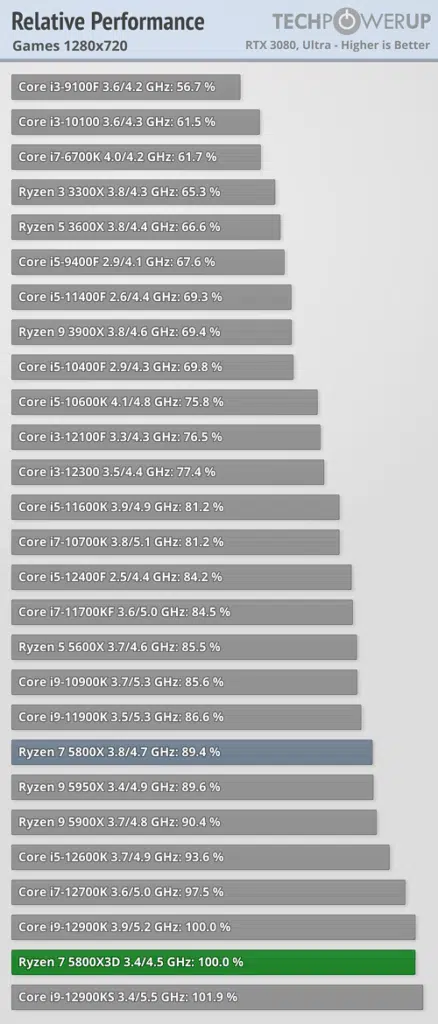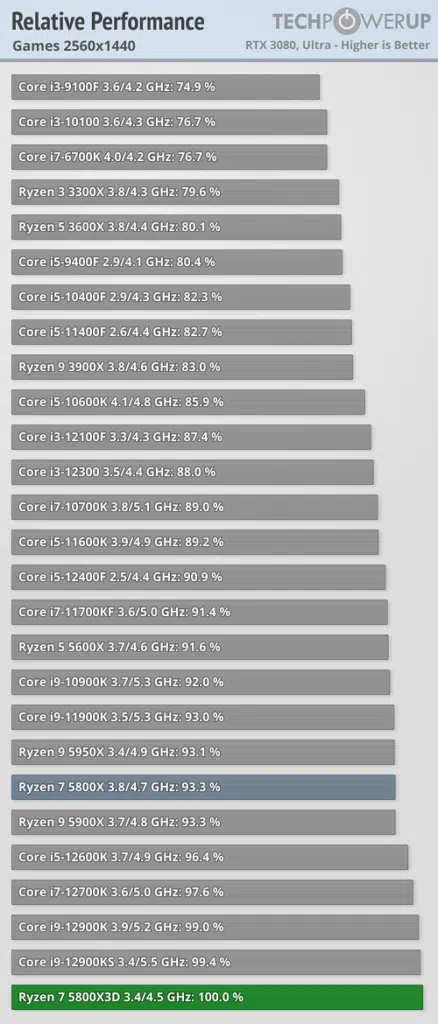
AMD has called its Ryzen 7 5800X3D processor with 3D V-Cache technology the fastest gaming CPU that the world has ever seen. It appears that red team’s marketing department wasn’t over-exaggerating with that statement, as a series of relative performance charts shared by TechPowerUp today can reveal that the Ryzen 7 5800X3D should perform quite similarly to Intel’s latest Alder Lake-S flagship, the Core i9-12900KS, in many of today’s most popular titles.
AMD’s Zen 3 chip was only bested by a difference of 1.9% and .2% in the 720p and 1080p charts, respectively, and it even manages to squeeze past the Core i9-12900KS under the 1440p setting with a .6% difference. The individual benchmark scores that can be viewed as part of TechPowerUp’s full review also include some interesting highlights, such as significant FPS gains in Borderlands 3 and Far Cry 5 under the 720p setting.




AMD Ryzen 7 5800X3D Review – The Magic of 3D V-Cache (TechPowerUp)
Averaged over our 10 games at the CPU-bottlenecked 720p resolution, the Ryzen 7 5800X3D can gain an impressive 10% in performance over its 5800X counterpart. This is enough to make it the fastest gaming CPU right behind the Intel Core i9-12900K and i9-12900KS. Considering Intel’s Alder Lake comes with a new and improved core architecture, runs almost 1 GHz higher, and has faster DDR5 memory, this is an impressive achievement. It also means Intel has defended their “World’s fastest Gaming Processor” claim, but differences are minimal when looking at the averages. Individual games will show vastly different results, though. The highlights here are Borderlands 3 and Far Cry 5. Borderlands 3, which has been extremely CPU limited in all our testing, gains an enormous 43% (!!) in FPS. Far Cry 5 is the most memory-sensitive title in our test suite; +35%, wow! The rest of our games do gain some FPS, but differences aren’t as big. You’re probably wondering why Counter-Strike CS:GO is only 5% faster. I suspect it’s because the game’s hot data already fits into the cache of most processors, so the larger L3 cache doesn’t have as much of an effect.
Moving to higher resolutions gamers actually play at, differences get smaller and smaller because the graphics card becomes the bottleneck and the CPU is no longer as much of a limiting factor. At those resolutions, the number of frames per second is also lower, which usually reduces CPU load and thus limits the gains that faster cache, or anything else in the CPU, can achieve. Still, even 5% at 1440p is a monumental achievement considering that AMD “merely” added more cache and is using the same processor architecture at lower clock speeds. I think it’s also important to highlight that we’ve measured the biggest gains at FPS rates that were already very high in the first place. For example, Borderlands 1080p goes from 97 FPS to 138 FPS. Unless you have a 120 Hz monitor or better, you won’t notice the increase in framerate. Latencies might be slightly better, however, which could matter to competitive gamers.
